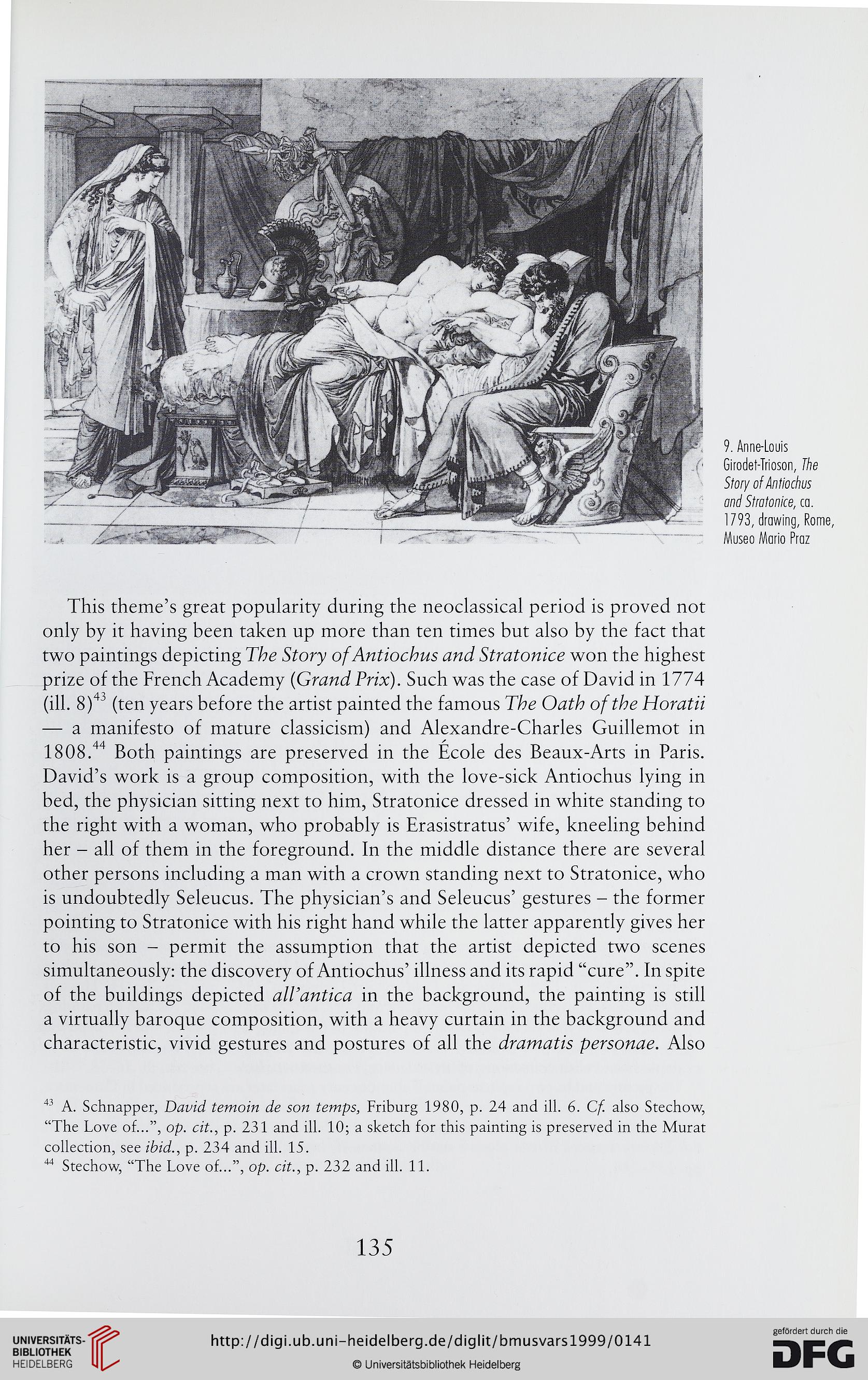9. Anne-Louis
Girodet-Trioson, The
Story ofAntiochus
and Stratonice, ca.
1793, drawing, Romę,
Museo Mario Praż
This theme’s great popularity during the neoclassical period is proved not
only by it having been taken up morę than ten times but also by the fact that
two paintings depicting The Story ofAntiochus and Stratonice won the highest
prize of the French Academy (Grand Prix). Such was the case of David in 1774
(ill. 8)4’ (ten years before the artist painted the famous The Oath ofthe Horatii
— a manifesto of maturę classicism) and Alexandre-Charles Guillemot in
1808.44 Both paintings are preserved in the Ecole des Beaux-Arts in Paris.
David’s work is a group composition, with the love-sick Antiochus lying in
bed, the physician sittmg next to him, Stratonice dressed in white standing to
the right with a woman, who probably is Erasistratus’ wife, kneeling behind
her - all of them in the foreground. In the middle distance there are several
other persons including a man with a crown standing next to Stratonice, who
is undoubtedly Seleucus. The physician’s and Seleucus’ gestures - the former
pointing to Stratonice with his right hand while the latter apparently gives her
to his son - permit the assumption that the artist depicted two scenes
simultaneously: the discovery ofAntiochus’ lllness and its rapid “cure”. In spite
of the buildings depicted all’antica in the background, the painting is still
a virtually baroąue composition, with a heavy curtain in the background and
characteristic, vivid gestures and postures of all the dramatis personae. Also
43 A. Schnapper, David temoin de son temps, Friburg 1980, p. 24 and ill. 6. Cf. also Stechow,
“The Love of...”, op. cit., p. 231 and ill. 10; a sketch for this painting is preserved in the Murat
collection, see ibid., p. 234 and ill. 15.
44 Stechow, “The Love of...”, op. cit., p. 232 and ill. 11.
135
Girodet-Trioson, The
Story ofAntiochus
and Stratonice, ca.
1793, drawing, Romę,
Museo Mario Praż
This theme’s great popularity during the neoclassical period is proved not
only by it having been taken up morę than ten times but also by the fact that
two paintings depicting The Story ofAntiochus and Stratonice won the highest
prize of the French Academy (Grand Prix). Such was the case of David in 1774
(ill. 8)4’ (ten years before the artist painted the famous The Oath ofthe Horatii
— a manifesto of maturę classicism) and Alexandre-Charles Guillemot in
1808.44 Both paintings are preserved in the Ecole des Beaux-Arts in Paris.
David’s work is a group composition, with the love-sick Antiochus lying in
bed, the physician sittmg next to him, Stratonice dressed in white standing to
the right with a woman, who probably is Erasistratus’ wife, kneeling behind
her - all of them in the foreground. In the middle distance there are several
other persons including a man with a crown standing next to Stratonice, who
is undoubtedly Seleucus. The physician’s and Seleucus’ gestures - the former
pointing to Stratonice with his right hand while the latter apparently gives her
to his son - permit the assumption that the artist depicted two scenes
simultaneously: the discovery ofAntiochus’ lllness and its rapid “cure”. In spite
of the buildings depicted all’antica in the background, the painting is still
a virtually baroąue composition, with a heavy curtain in the background and
characteristic, vivid gestures and postures of all the dramatis personae. Also
43 A. Schnapper, David temoin de son temps, Friburg 1980, p. 24 and ill. 6. Cf. also Stechow,
“The Love of...”, op. cit., p. 231 and ill. 10; a sketch for this painting is preserved in the Murat
collection, see ibid., p. 234 and ill. 15.
44 Stechow, “The Love of...”, op. cit., p. 232 and ill. 11.
135




